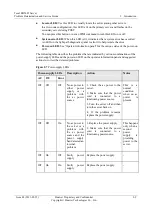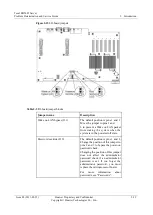
Tecal RH5485 Server
Problem Determination and Service Guide
3 Diagnostics
Issue 02 (2011-05-25)
Huawei Proprietary and Confidential
Copyright © Huawei Technologies Co., Ltd.
3-21
3
Diagnostics
This chapter describes the diagnostic tools that are available to help you solve problems that
might occur in the server.
3.1 Diagnostic tools
The following tools are available to help you diagnose and solve hardware-related problems:
Light path diagnostics
Use light path diagnostics to diagnose system errors quickly. See “Light path
diagnostics” for more information.
Troubleshooting tables
These tables list problem symptoms and actions to correct the problems.
See“Troubleshooting tables”.
POST error codes and error logs
The power-on self-test (POST) generates messages to indicate successful test completion
or the detection of a problem. See “POST error codes” for more information.
Checkpoint codes
Checkpoint codes track the progress of POST routines at system startup or reset.
Checkpoint codes are shown on the checkpoint display, which is on the light path
diagnostics panel.
3.2 Event logs
Error codes and messages are displayed in the following types of event logs:
POST event log:
This log contains the three most recent error codes and messages that
were generated during POST. You can view the POST event log from the Setup utility.
System-event log:
This log contains POST and system management interrupt (SMI)
events and all events that are generated by the BMC that is embedded in the IMM. You
can view the system-event log through the Setup utility.
The system-event log is limited in size. When it is full, new entries will not overwrite
existing entries; therefore, you must periodically save and clear the system-event log
through the Setup utility. When you are troubleshooting, you might have to save and then
clear the system-event log to make the most recent events available for analysis.
Messages are listed on the left side of the screen, and details about the selected message
are displayed on the right side of the screen. To move from one entry to the next, use the
Up Arrow (↑) and Down Arrow (↓) keys or the Page Up and Page Down keys.
















































